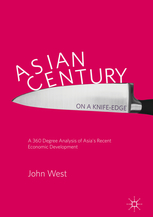 John West. Asian Century … on a Knife-edge: A 360 Degree Analysis of Asia’s Recent Development. Palgrave Macmillan. 2018. 335 pages.
John West. Asian Century … on a Knife-edge: A 360 Degree Analysis of Asia’s Recent Development. Palgrave Macmillan. 2018. 335 pages.
Kishore Mahbubani, the Singaporean diplomat and academic, is perhaps the most outspoken proponent of the notion that this is Asia’s century. In 2015 Mahbubani pronounced that “the last two centuries of Western domination of world history have been a major historical aberration”; that “aberrations come to a natural end”; and that “[t]herefore the Asian Century is irresistible and unstoppable”. In his latest book, John West, Director of the Asian Century Institute, takes a more guarded view, highlighting how both recent events and a range of fundamental problems place the world’s most promising region at grave risk.
Unsurprisingly, West starts with the uncertainties introduced by the Trump administration, from rising trade protectionism and a lack of strategic consistency to the heightened risk of armed conflict on the Korean peninsula.
West debunks two common myths: that the region’s continued high growth is inevitable, and that it will be driven by a large and booming middle class. In sharp contrast to Asia’s “miraculous” past performance, West reminds us of the myriad problems facing its economies.
Japan is caught in a deflationary trap, with an unreformed labour market and tacit constraints on foreign competition. South Korea is dominated by family-led chaebols that skew the playing field and hold back innovation. China, the region’s largest economy, relies on government-led investment and inefficient state-owned enterprises, and has for years kept reforms on the back burner for fear of generating a social backlash. India, one of the bright spots in West’s analysis, is constrained by widespread poverty and a weak education system. In short, West sees little scope for a global economic leader to emerge from Asia in the foreseeable future.
Where Mahbubani waxes lyrical about the dynamism and promise of Asia’s middle class, West points out that the vast majority of the new middle class live precariously close to the poverty line, with little purchasing power or impact on social values. Throughout the region, high growth rates have been accompanied by rapidly increasing inequality and a surge in the numbers of super-rich.
West describes Asia as suffering from stunted economic and social development. He highlights seven challenges that the region will need to address before it can become a high-income economy. These range from getting better value out of global value chains, making societies more inclusive, and combating rampant corruption to addressing Asia’s weak governance and lack of democratic institutions.
West reminds us that authoritarianism is on the rise, and that corruption is rampant. Myanmar and Thailand are led by repressive military regimes, and Indonesia by a political and economic oligarchy, while the Philippines Government sanctions brutal extrajudicial killings. Malaysia’s leaders are blatantly corrupt, while the Japanese political system suffers from more subtly institutionalised corruption.
Moreover, Asian countries seem incapable of working well together to address disagreements and problems. As West sees it, the greatest threat to Asia’s development lies in the complacency of its elites.
West’s analysis is timely, insightful, and highly readable. Many recent studies have focused on specific problems, such as Asia’s yawning infrastructure gap and the implications of artificial intelligence and robotics. West paints with a much broader brush. He provides welcome coverage of the trampled rights of ethnic minorities, women, children, and the LGBT community. Cybercrime and cyberwarfare are on the rise and would have deserved more space.
Asia’s shortcomings are many, and its challenges daunting. West makes a compelling case against excessive exuberance about the region’s future. Solid growth expectations this year in all major regions have fuelled global optimism. West provides a timely reminder of how easily things could unravel.
Asian Century … on a Knife-edge is available both commercially and on open access, reflecting the priority that West attaches to sharing his views with the largest possible audience. The book was prepared on an admirably tight budget. The downside, albeit a minor one, is that it would have benefited from a final round of proofreading.
Having retired from the OECD and the Asian Development Bank Institute, West decided to focus on writing about what interests him most, and set up the Asian Century Institute, which publishes a wide-ranging e-newsletter. Asked where the Institute is based, the globetrotting West confided that it consists of his laptop and a network of helpful colleagues and friends.
In an age when publishers are struggling to survive, West is ahead of the curve.

